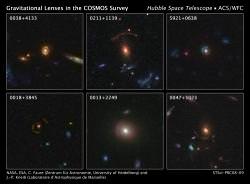One of the breakthroughs in modern astronomy is the use of gravitational lenses, where a closer galaxy or star focuses the light from a more distant object. The more astronomers look, the more they find these helpful objects, allowing them to peer at objects much further away. The number of known gravitationally-lensed galaxies jumped up today, when astronomers announced another 67 new lenses.
These 67 lenses were part of the COSMOS project; a detailed survey of small region of the sky about the same as 9 times the area of the Moon. Both Earth and space-based telescopes are working together to provide a survey of the sky which is very deep. And one of the key instruments in the project is the Hubble Space Telescope.
One of the big surprises of this survey is just how many lenses turned up in such a small area of the sky. Based on this discovery rate, researchers think that there could be 500,000 similar gravitationally-lenses galaxies out there.
At least 4 of the lenses are Einstein rings. This is a situation where the foreground and background galaxy are lined up so perfectly, the distorted distant galaxy forms a ring around the closer one.
In order to find the lenses, astronomers had to sift through a collection of 2 million candidate galaxies. Then the researchers had to look through each COSMOS image by eye and identify any potentially strong gravitational lenses. Finally, they checked both the foreground and background galaxy to make sure that they’re really two separate objects separated by billions of light years, and not just a strangely shaped galaxy.
Now that the researchers have so many gravitational lenses, they can do some really interesting things. For example, they’ll be able to study the dark matter distribution around the galactic lenses. And they’ll also be able to start accumulating a census of galaxy masses to see if they match predictions.
Original Source: Hubble News Release


Nice pricture. If the Cosmos project would follow the galaxy-zoo approach they could cover many more regions!
i’m looking forward to the possible discovery of compound gravitational lenses. then we’ll be able to see waaay back!
I am sure that as we peer into these Galaxies eventually we will find something thats breathing!
I’m by no means a scientist but, if we can now see objects that are billions of lightyears away, and the universe is only estimated to be about 13.7 billion years of age then somthing is not right. As galaxy is not formed overnight even by astronmical stadards. The light we see coming from them may make us have to recalculate the age of a lot of things.
Since the ancestral time, world space research is progressing on wrong concept because we unknown about space mirror which is a great mystery and creator of lots of mysteries viz. milk ways, galaxies, nebulas, white drafts, black holes etcs. Hence without study of space mirror the space research has no future.
Therefore it invites to visit http://www.spacemirrormystery.com to know the original truth and for prosperous space research.
Mirror reflects frontier. Mirror functions like a wall. There is nothing ahead of mirror but reflection makes lively atmosphere into mirror. If two mirrors face each other in parallel position the concerned area between mirrors is converted to a biggest atmosphere because the concerned area reflected unlimitedly as front side and backside into each mirror frequently. Space mirror is based on above rule and we are unknown about space mirror. Since from sun the objects of area 225 million kilometer to 300 million kilometer of solar system reflects unlimitedly, we find a very deep space and through giant telescopes we watch mystery after mystery. Telescope enlarges view not closes near view. Following may clear the concept “A visitor of a desert often find mirage. If he moves mirage also moves. He can never reach near the mirage. If he tries he can see enlarge view of mirage as smoky atmosphere through a telescopic instrumentâ€.
Giant telescope like Hubble may be the milestone of our technology but it can not help the real space research.